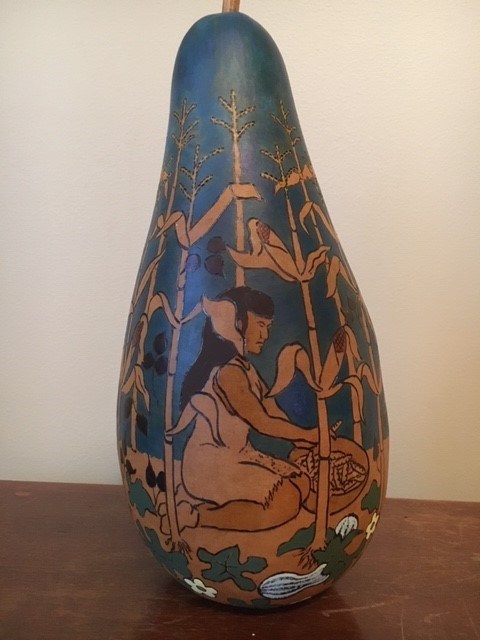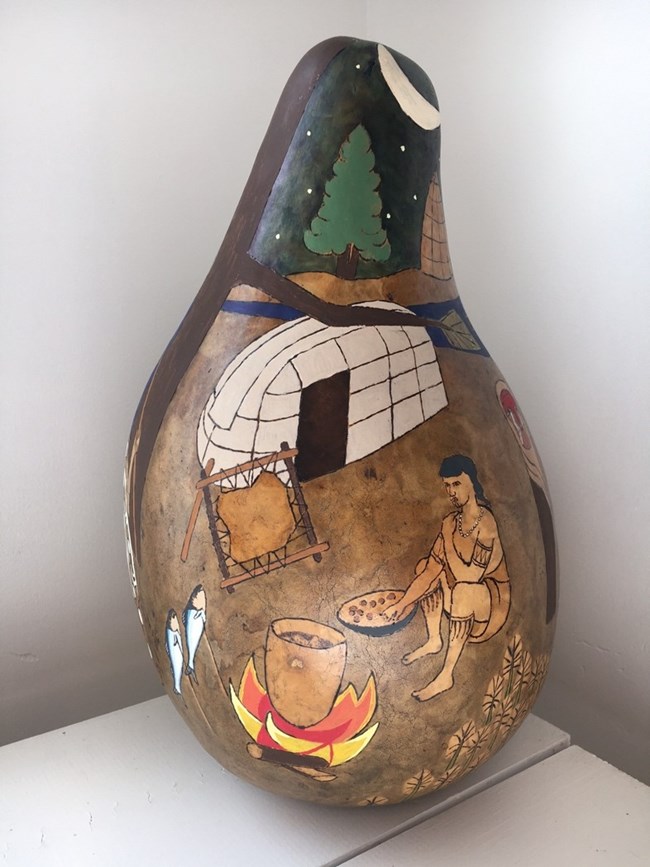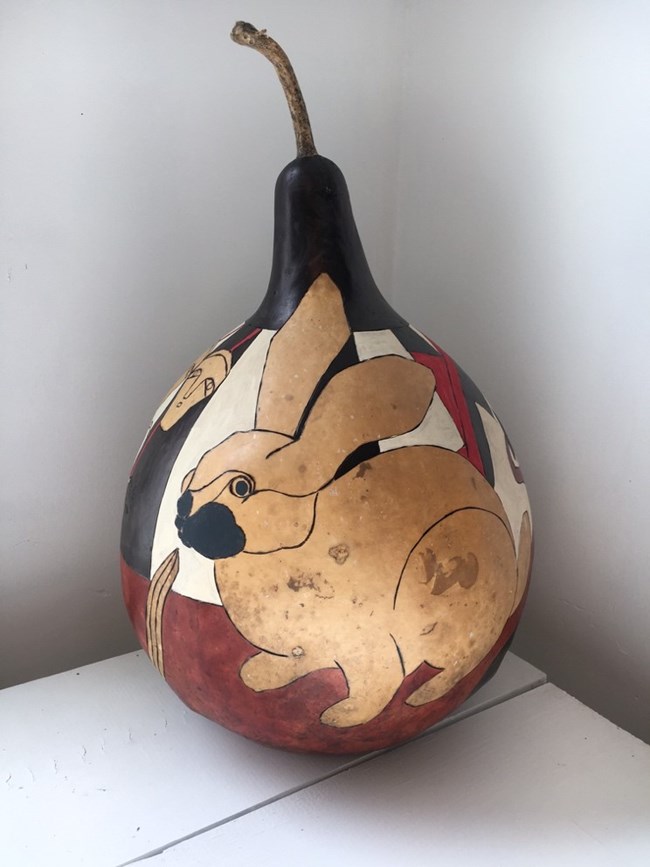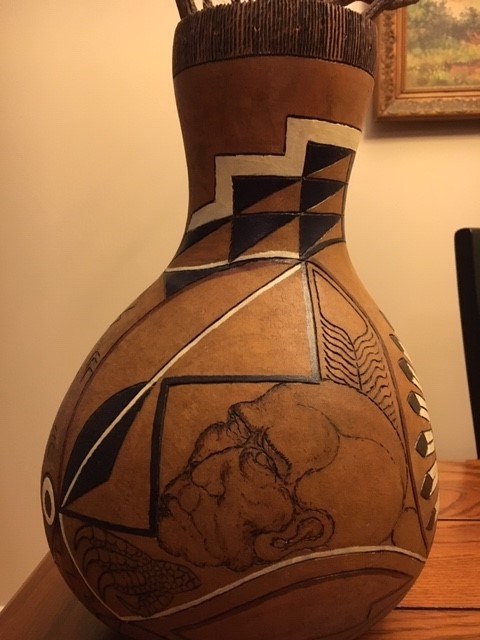Last updated: April 15, 2022
Article
Indigenous Artistry: Ethan Brown

Ethan Brown

Ethan Brown
This article was originally published July 29, 2020 on FindYourChesapeake.com.
Exploring the Indigenous Communities of the Chesapeake: The Pamunkey Indian Tribe
Ethan Brown is a citizen of the Pamunkey Indian Tribe. He has resided on the Pamunkey Indian Reservation, located along the border of King William, Virginia, for about thirteen years. The Pamunkey Indian Tribe is a federally recognized tribe in the United States, and the Pamunkey Indian Reservation is one of the two oldest reservations in the country.
Ethan is a Pamunkey artist who creates contemporary art in many different forms and mediums, including gourd art, wood sculpting, oil painting, pottery, and filmmaking. Over the past three years, Ethan has worked on creating short films and is experimenting with writing screenplays. During the interview, Ethan discusses Pamunkey art and how he expresses cultural heritage through various mediums of art, all special in their own way. Ethan does not have a preconceived notion or method of what he is aiming to accomplish in his art, rather he allows his art to flow naturally and organically.
“Each medium is its own thing, and it is just about creativity and coming up with a final piece based on ideas you started out with.”
-Ethan Brown, Pamunkey artist
How many years have you been making gourd art?
Gourd art specifically, about twelve years ago when I was eighteen, nineteen years old. I had just moved onto the reservation. My grandmother made gourd art, and my uncle was an accomplished artist. We have a gift shop at our museum, so I began making art to sell there and got more inspired to further my artwork.
When did you discover your passion for gourd art? For painting gourds? Was there a tradition in your family?
Gourd art specifically was something my grandma had made. I was watching her make it. Also, it is a medium you can grow. I grow gourds and then don’t have to pay for a canvas-- that is one plus.
Traditionally, gourds were a part of the culture, but they were not decorated the way I make them. I use contemporary techniques to create gourd art. I like the look of wood-burning the outline of the artwork into the gourd. I just like that process and adding in the different colors and stains--I like how it looks.

Ethan Brown
What process do you enjoy the most when designing the gourds?
The process I enjoy the most is probably just imagining what I am trying to depict on the gourd and coming up with the design.
Once I have the pencil drawing on the gourd, then everything from there is sort of just mindless work and I do not have to think about it anymore. I wood- burn the pencil lines in and then intuitively color the different areas.
What specific stories do you want people to take away from your artwork?
I don’t really approach it in that way--to want people to take away something. I do more of what inspires me in the moment… It is up to interpretation by people who look at it or buy it.
I do really like storytelling and I work in other media, too. I’ve been getting involved in filmmaking over the past couple of years. But even then, I like approaching it like I do my artwork: what I am interested in making, rather than trying to have some preconceived notion of a story.
What specific films have you been working on and wanting to show?
I am just wrapping up a short film that was partly sponsored by UVA’s Religion, Race, and Democracy Lab. I worked with a professor, Federico Cuatlacuatl and a graduate student, Caleb Hendrickson, from there, as well as a sound artist in Richmond, Joshua Rodenberg. The film we made was an abstract approach to a short film using some traditional symbology and creation story elements. Also, I have experimented with writing screenplays the past three years--nothing that has turned into anything, but has been practice for me. Three years ago, my dad started directing the Pocahontas Reframed Film Festival in Richmond. Getting to network with all these native filmmakers-- that is what inspired me to start thinking about film as a medium.

Ethan Brown
Is there a memory or story that stands out to you in regard to tribal art?
Not that I can think of. [My art] is a mixture of everything I’ve read about art, history, and culture. Everything I know from living here on the reservation and just hearing the stories from our community.
Also just taking what I like about nonnative art or native art, just visual aesthetics, design, and storytelling, and mixing them all together. There are so many different stories or ways to approach it. Even if you pick one theme, I could make one hundred different gourd art pieces within the same theme-- use different colors, different ways to achieve it. Every medium is like that.
The inspiration-well doesn’t really run dry once you realize that. It’s just about choosing, and sometimes that can hold you up because with everything you work on, there are one thousand different directions you can take it. You just take it in a direction, you just let it go in the direction it wants to go. Each piece wants to be what it is eventually going to be. You just have to get it there.
How do you envision your artwork to evolve five or ten years from now as you continue to represent your tribes’ cultural heritage?
Hopefully I can work on more film projects moving forward, because it is a deeper medium for storytelling. I am going to keep doing visual artwork because I enjoy it. Basically, I just try to make visual artwork that I would want on my shelf, and then I put it in the museum gift shop to sell. Then, not having it on my shelf, is impetus to make another piece. I am going to keep creating visual art. Moving into film as a medium opens up more advanced, complex storytelling elements.
Intuition is how I approach it, so I just try to dream stuff up in the moment and start writing it down or drawing it.
That is my approach to it.
Could you go into more detail about the creation myth story? You had made a commission for Chesapeake National Parks using that theme on a gourd. What does the creation myth entail or how was it passed down from each generation?
Well, that was a recorded story about the Creator Spirit who takes the form of a Great Hare and comes from the rising sun carrying a magic bag that man and woman are kept inside of. The Great Hare creates the mountains and the forests and the rivers, and then pulls a Great Deer from the bag and puts it into the land. But the four winds get jealous of this Creation, and come at night to slay the Great Deer. Finding the slain deer, the Creator Spirit then gathered all of its tiny hairs together and dispersed them across the land, each hair in turn becoming a lesser deer so that man and woman would have sustenance. And then the Great Hare pulled man and woman out of the bag to live in harmony.
But unfortunately, no it wasn’t a story that was passed down from generations, at least not to me; it was something I read in a book. The tribal genocide back in the day sort of stopped lots of traditional knowledge from being passed down from way back then- you weren’t allowed to speak your language or practice your ceremonies. Culture evolves through time though, so I am more connected to a lot of the culture that has been here on the reservation. Over three hundred years, that isn’t that traditional culture, but it is still our culture, what our community has gone through throughout all these time periods. So, I am inspired by that for artwork as well.
And that is where artwork comes in for me personally. It is a way to examine everything that has been written in the historical record, to take the stories I know from my community, to take my experiences with other Native communities, to dream and use intuition, and then through art to make new connections. To rediscover things.

Ethan Brown
Which lands do you wish to protect and conserve? For now, and future generations?
Hopefully we don’t destroy our planet and make it uninhabitable. I celebrate the East Coast we live on-- a forest. Traditionally, we are a forest culture. I celebrate all the different things that go along with that.
Ethan envisions diving deeper into filmmaking and cinematography and has been working alongside others on short films. Ethan describes how filmmaking allows for more effective and deeper storytelling.
Stay tuned! For Ethan’s upcoming short film.
Title: Tsenacommacah
Created by Ethan Brown, Federico Cuatlacuatl, Caleb Hendrickson
Sound Design by Joshua Rodenberg
Location: All scenes were filmed on the Pamunkey Reservation
The public can view and purchase Ethan’s artwork, along with the art of several other Pamunkey tribal citizens, at the Pamunkey Indian Museum’s gift shop.
For more information about the Pamunkey Tribe, visitation hours, and operations, visit the Pamunkey Indian Tribe’s official website.
CARLY SNIFFEN
As an Interpretive Outreach Assistant, Carly hopes to share her passion for the environment with the community by working to develop and promote community engagement and working to restore and protect the Chesapeake Bay watershed.
